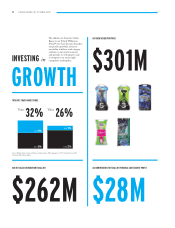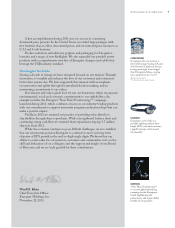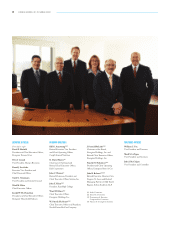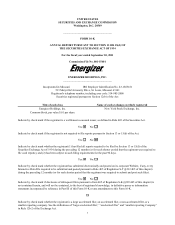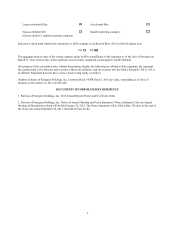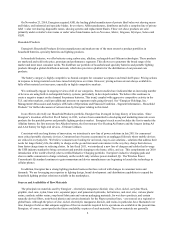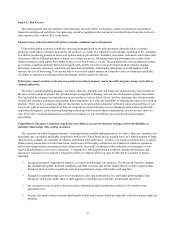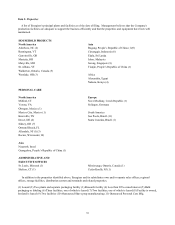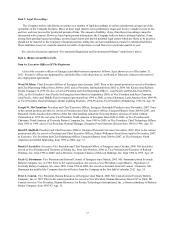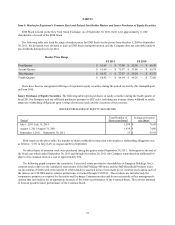Energizer 2011 Annual Report Download - page 18
Download and view the complete annual report
Please find page 18 of the 2011 Energizer annual report below. You can navigate through the pages in the report by either clicking on the pages listed below, or by using the keyword search tool below to find specific information within the annual report.Seasonality
Sales and operating profit for Household Products tends to be seasonal, with increased purchases of batteries by consumers
during the December holiday season, and increases in retailer inventories during autumn. In addition, natural disasters such as
hurricanes can create conditions that drive increased needs for portable power and spike battery and flashlight sales. The wet
shave business does not exhibit significant seasonal variability.
Customer orders for sun care products are highly seasonal, which has historically resulted in higher sun care sales to
retailers during the late winter through mid-summer months.
Competition
The Household Products and Personal Care businesses are highly competitive, both in the United States and on a global
basis, as large manufacturers with global operations compete for consumer acceptance and, increasingly, limited retail shelf
space. Competition is based upon brand perceptions, product performance, customer service and price.
Our principal battery competitors in the U.S. are Duracell International, Inc., a subsidiary of Procter & Gamble Company,
and Spectrum Brands, Inc. We believe private-label sales by large retailers has some impact on the market in some parts of the
world. Duracell and Panasonic are significant competitors in South and Central America, Asia and Europe, and local and
regional battery manufacturers in Asia and Europe also compete for battery sales.
The global shaving products business, comprised of wet shave blades and razors, electric shavers, lotions and creams, is a
growing consumer product segment worldwide. The wet shave segment of that business, the segment in which we participate,
is further segmented between razor systems and disposable products. Geographically, North America, Western Europe and
Japan represent relatively developed and stable markets with demographic trends that result in a stable, predictable number of
shaving consumers. We believe that those markets will rely primarily on new premium priced product introductions for growth
as category blade unit consumption has been relatively flat for a number of years. As a result of demographic trends, however,
there is a growth trend predicted for the wet shave segment in Latin American, Asian and Eastern European countries. Our
principal competitors in the wet shave business worldwide are Procter & Gamble Company which owns the Gillette brand and
is the leading company in the global wet shave segment, and Bic Group, which competes primarily in the disposable segment.
The markets for skin care, feminine care and infant care products are also highly competitive, characterized by the frequent
introduction of new products, accompanied by major advertising and promotional programs. Our competitors in these product
lines consist of a large number of domestic and foreign companies, including Procter & Gamble Company and Kimberly-Clark
Corp. in feminine care, Merck & Co., Inc. and Johnson & Johnson in skin care, and a variety of competitors in the fragmented
infant care market. In feminine care, we believe private label sales by large retailers in the U.S. have been growing.
Governmental Regulation and Environmental Matters
Energizer's operations are subject to various federal, state, foreign and local laws and regulations intended to protect the
public health and the environment.
The Company has received notices from the U.S. Environmental Protection Agency, state agencies, and/or private parties
seeking contribution, that it has been identified as a “potentially responsible party” (PRP) under the Comprehensive
Environmental Response, Compensation and Liability Act, and may be required to share in the cost of cleanup with respect to
eight federal “Superfund” sites. It may also be required to share in the cost of cleanup with respect to two state-designated sites,
and certain international locations. Liability in the U.S. under the applicable federal and state statutes which mandate cleanup is
strict, meaning that liability may attach regardless of lack of fault, and joint and several, meaning that a liable party may be
responsible for all of the costs incurred in investigating and cleaning up contamination at a site. However, liability in such
matters is typically shared by all of the financially viable responsible parties, through negotiated agreements. Negotiations with
the U.S. Environmental Protection Agency, the state agencies that are involved on the state-designated sites, and other PRPs are
at various stages with respect to the sites. Negotiations involve determinations of the actual responsibility of the Company and
the other PRPs at the site, appropriate investigatory and/or remedial actions, and allocation of the costs of such activities among
the PRPs and other site users.
The amount of the Company's ultimate liability in connection with those sites may depend on many factors, including the
volume and toxicity of material contributed to the site, the number of other PRPs and their financial viability, and the
remediation methods and technology to be used.
8


